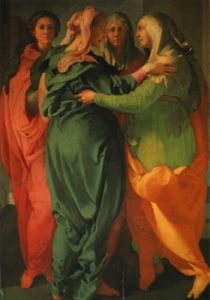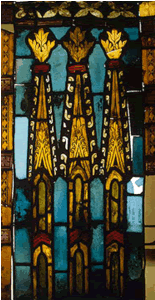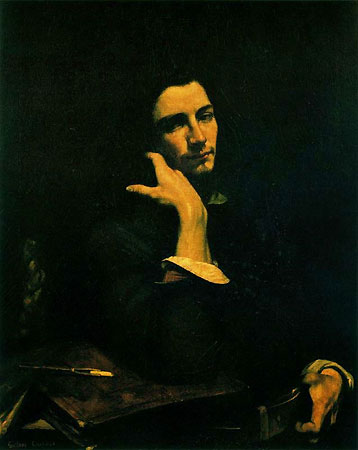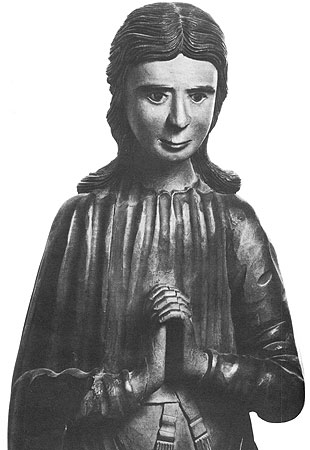Mannerism
 Pontormo Jacopo. Meeting of Mary and Elizabeth Mannerism (Italian. Manierismo – pretentiousness, mannerism from maniera – method, method) – the name conventionally denoting stylistic trends, as well as a certain stage in the development of European, mainly Italian, art of the middle and late 16th century. This stage reflected the crisis of the artistic ideals of the Italian Renaissance. The art of Mannerism as a whole is characterized by the primacy of form over content. Exquisite technique, virtuosity of manner, demonstration of skill does not correspond to the paucity of design, secondary nature and imitation of ideas. In Mannerism there is fatigue of style, the exhaustion of its vital sources. That is why this term is often interpreted more broadly, referring to Mannerism as the last, crisis phase of the development of any artistic style in various historical eras.
Pontormo Jacopo. Meeting of Mary and Elizabeth Mannerism (Italian. Manierismo – pretentiousness, mannerism from maniera – method, method) – the name conventionally denoting stylistic trends, as well as a certain stage in the development of European, mainly Italian, art of the middle and late 16th century. This stage reflected the crisis of the artistic ideals of the Italian Renaissance. The art of Mannerism as a whole is characterized by the primacy of form over content. Exquisite technique, virtuosity of manner, demonstration of skill does not correspond to the paucity of design, secondary nature and imitation of ideas. In Mannerism there is fatigue of style, the exhaustion of its vital sources. That is why this term is often interpreted more broadly, referring to Mannerism as the last, crisis phase of the development of any artistic style in various historical eras.
Mannerism always indicates the degeneration of one and the imminent coming of a new style. This role was most clearly manifested in Italy, where the mannerist tendencies foreshadowed the birth of Baroque. H. Wölflin wrote that it was not by chance that Mannerism was so powerfully developed in Italy, where “the cult of the nude body plastics was especially developed … In the movement of figures, Leonardo and Michelangelo … every moment threatens to turn into artificiality and mannerism.” J. Vasari criticized the painting of the Italian Quattrocento with the words “aspro a vedere” (ital. “Tough for sight”, meaning probably strict, tectonicity and sculpturalism in the interpretation of the form of early Florentine Classicism.
For the first time, the term “maniera” began to acquire a special meaning in the middle of the 16th century in Venetian painters, who used it with a touch of “new manner” (Italian “maniera nuova”) to denote the style of work of contemporary artists, unlike the older generation: J. Bellini, Giorgione, Titian. In this sense, the term “manner” meant a positive assessment of the new, original, original in art, going beyond the boundaries of the classical tradition.
For the first time after the Renaissance, the harmony of content and form, image and expression that had been achieved so hard began to disintegrate due to the overdevelopment and aesthetization of individual elements, graphic means: lines and silhouette, colorful spots and textures, strokes and strokes. The beauty of a single detail became more important than the beauty of the whole. This path is inevitable for the evolution of the forms of any artistic style, but the greatest Renaissance in its artistic achievements was also created by outstanding Mannerism.
In the architecture of Italy of the second half of the XVI century. Mannerism manifested itself in arbitrary mixing and illogical use of elements of various orders, Romanesque and Gothic archaisms.
Early mannerism in Florence is provided by the works of J. Pontormo, an outstanding artist who worked under strong influence, who was in Florence from 1520-1534 in Michelangelo. Therefore, Pantormo’s Mannerism was distinguished by high spirituality, despite its clearly imitative nature. The next generation of Florentine mannerists: a pupil of Pontormo A. Bronzino, as well as J. Vasari, B. Bandinelli, the former court painters of the Duke of Florence, Cosimo I Medici, O. Gentileschi, A. Manyasco, Parmigianino, F. Salalleati and many others gradually lost this quality , why their art is even called “mannere manierism” (maniere manierismo). This term is proposed in 1963. D.Smith.
Late mannerists, feeling the inconsistency of classical norms with the needs of time, destroyed the compositional links, but, unlike Baroque artists, could not find a new organizing spatial principle.



